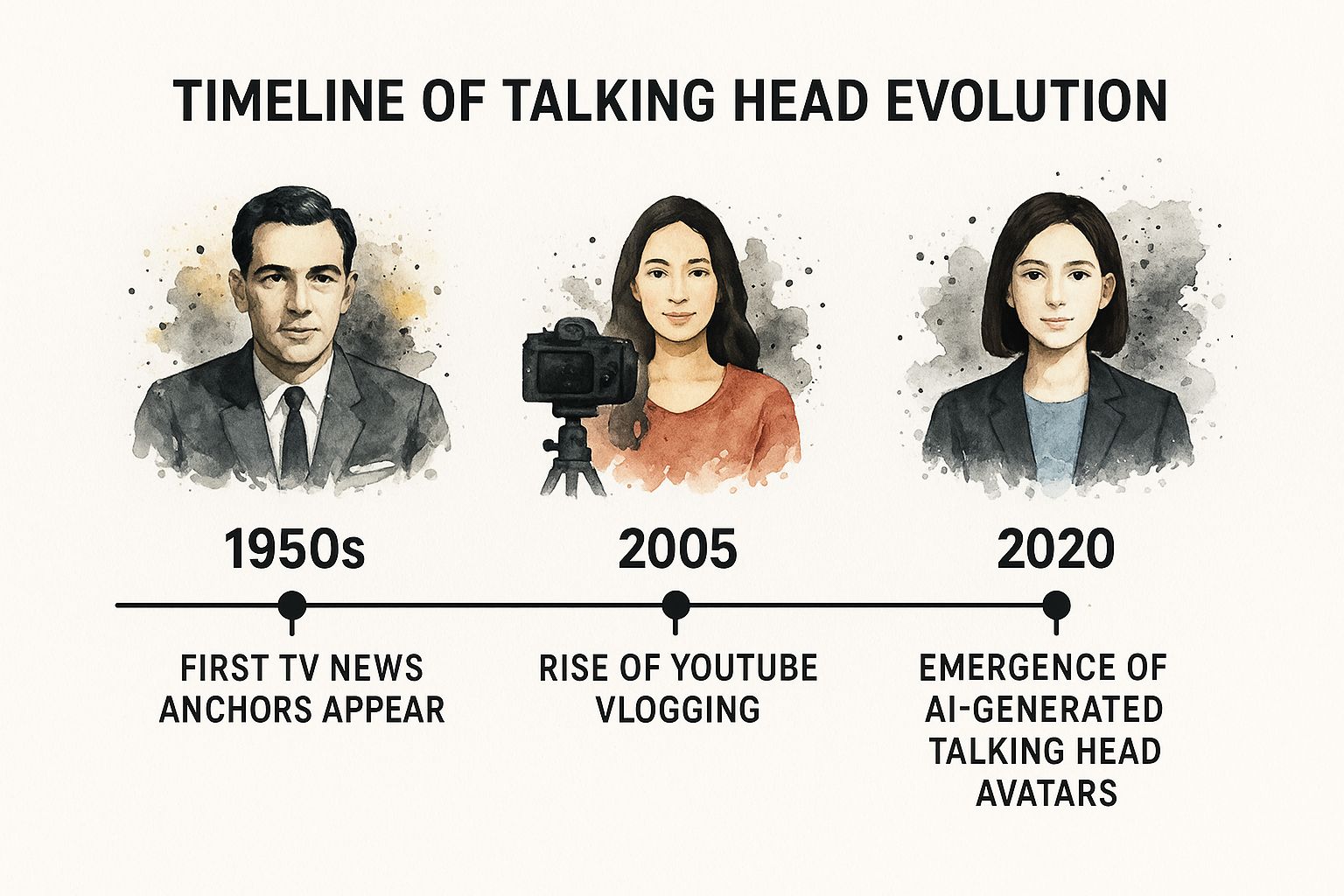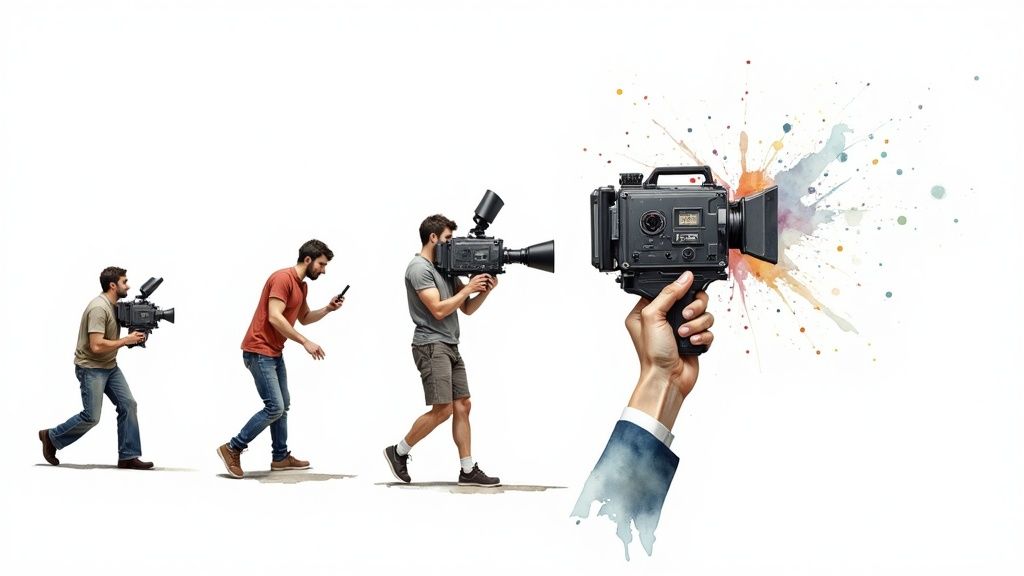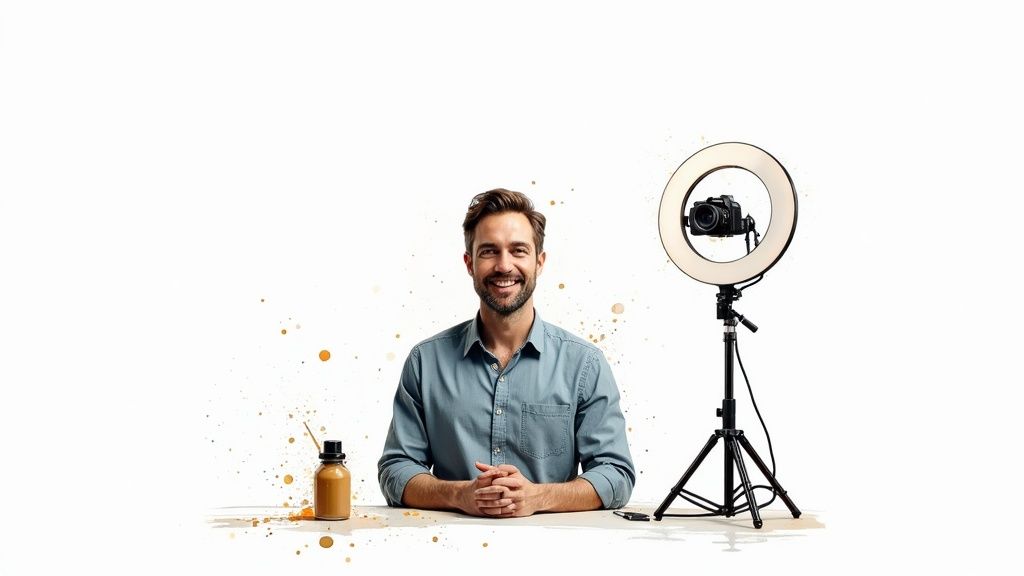Ever seen a video that’s just someone speaking directly to you, from the shoulders up? That’s a talking head video. It’s a beautifully simple but incredibly potent format that cuts through the noise, putting all the focus on two things: the message and the messenger.
Think of it as a direct conversation, one designed to build a real sense of trust and connection with the viewer.
The Core Elements of a Talking Head Video

At its heart, a talking head video is really just a conversation. It's less of a formal presentation and more like a one-on-one chat with an expert you trust. The format is built on a few straightforward elements that work together to create that personal connection and deliver information with absolute clarity.
The main goal here is to be authentic and clear. By stripping away complicated backgrounds or fancy sets, the video puts the speaker’s personality, credibility, and expertise right in the spotlight.
The Speaker and The Message
The foundation of any talking head video is, naturally, a speaker delivering a message. This could be anyone—a news anchor giving the day's updates, an industry expert breaking down a complex topic, or a CEO sharing a company vision. What makes it work is the speaker's ability to be direct and engaging, combining clear speech with natural body language.
The most successful talking head videos feel like a dialogue, not a monologue. The speaker isn’t just reciting information; they are connecting with the viewer on a personal level, building a foundation of trust and authority with every word.
To get a real sense of where this fits, it helps to look at the overall content creation landscape. This format is a go-to tool for anyone looking to put a human face on their brand or message.
Direct Gaze and Audience Connection
One of the defining features of this style is the speaker's direct gaze into the camera lens, which creates the feeling of genuine eye contact with the viewer. This is the secret sauce for building a bond and keeping someone's attention. It creates an intimacy and immediacy that other, more cinematic video styles just can't match.
If you’re looking to really nail this approach, digging into different video storytelling tips can offer some fantastic insights on how to make your message truly hit home.
From Broadcast News to Your Social Feed
The talking head video might feel like a modern invention, but its roots go way back—long before social media was even a flicker of an idea. To really get a handle on its power, we need to trace its journey from the black-and-white TV sets of yesteryear to the vibrant, chaotic world of our online feeds today. It’s a story of survival and connection.
The basic concept popped up when sound first came to film, but it truly found its footing in television newsrooms. Back in the 1950s, news anchors were the original talking heads, sitting behind a desk and delivering information with a sense of authority and calm. This direct-to-camera style became the gold standard for building trust and creating a powerful one-on-one link with the viewer. If you're curious about these early media dynamics, you can learn more about the history of talking heads on dokrevue.com.
The Digital Evolution of a Classic Format
As media began to shift, the talking head didn't just hang on; it adapted. It didn’t just survive the jump to digital platforms, it actually thrived by taking its core strengths and applying them to new audiences and technologies. What started as a formal way to deliver the evening news became a super flexible tool for everything from vlogs to viral explainers.
At its heart, the talking head format has always been about creating a direct, personal connection. That fundamental appeal is precisely why it's made the leap across every major media shift, from broadcast television to bite-sized TikTok clips.
This timeline shows just how far the format has come, from its simple broadcast origins to its AI-powered future.

It's pretty clear from this visual just how resilient the format is. It just keeps reinventing itself for the next thing.
From YouTube Vlogs to AI Avatars
The mid-2000s and the arrival of YouTube changed everything. A whole new generation of creators grabbed the talking head format and ran with it, turning it into the casual, chatty vlog style we all recognize. This was a huge deal. It basically democratized video, proving that anyone with a camera and something to say could build an audience through authentic, straight-to-the-point communication.
Now, we're in the middle of the next big shift: AI. Today, you can generate a realistic digital avatar from nothing but text, creating a talking head video without ever needing a camera or even a human presenter. This is once again changing the game and redefining what is a talking head, making it easier and more accessible than ever to create video content.
The Psychology of Why Talking Head Videos Connect

What is it about watching someone speak directly to a camera that just works? The answer is pure human psychology. Talking head videos tap into our built-in desire for connection by basically faking a face-to-face conversation.
When a speaker looks straight into the lens, our brains register it as genuine eye contact. That simple act creates an instant feeling of intimacy and trust, turning what could be a boring monologue into a personal chat. It’s a fantastic way to put a human face on a brand or make complicated topics feel way more approachable.
This direct approach doesn't just build trust, either. It also cements authority. By stripping away all the fluff and distractions, the format puts a spotlight squarely on the speaker's expertise and confidence.
Building Trust Through Authenticity
The raw, unfiltered feel of a well-made talking head video is its secret weapon. An authentic delivery, complete with natural gestures and a conversational tone, makes the speaker seem both relatable and trustworthy.
This format’s power comes from its simplicity. It tells the audience, "Here I am, speaking directly to you," creating a bond that polished, high-production videos often struggle to achieve. When viewers feel a genuine connection, they are far more likely to listen, learn, and engage.
This personal connection is a cornerstone of building an active, loyal audience. You can amplify this effect even further by exploring different audience engagement techniques that work hand-in-hand with this format.
The Practical Advantages for Creators
The psychological impact is huge, but let's be real—the practical benefits are what make this format a go-to for creators and businesses everywhere. It just tears down so many of the usual barriers to making video.
Let's break down the core benefits that make the talking head format such a powerhouse for building both audience connection and authority.
The Strategic Advantages of Talking Head Videos
| Benefit | Psychological Impact | Strategic Business Use |
|---|---|---|
| Authenticity & Trust | Simulates a one-on-one conversation, making the speaker feel genuine and relatable. | Builds brand loyalty and a stronger connection with your audience. |
| Authority & Expertise | The direct, focused format highlights the speaker’s knowledge and confidence. | Positions your brand or expert as a thought leader in your niche. |
| Simplicity & Focus | Minimal distractions keep the viewer's attention locked on the message and the messenger. | Ensures key messages are delivered clearly and without clutter. |
| Emotional Connection | Facial expressions and tone of voice convey nuance and emotion that text can't match. | Fosters a deeper, more memorable bond with viewers. |
Ultimately, the talking head video's blend of psychological resonance and practical ease makes it a smart, scalable tool for any modern content strategy. It's a format that works because it's built on how we, as humans, are wired to connect.
The Rise of the Professional Talking Head
You’ve seen them everywhere. On cable news, in documentaries, and all over your YouTube feed. The "talking head" has gone from a simple video format to a full-blown career path. Today, professional experts, commentators, and influencers are building entire brands just by sharing their insights directly with an audience.
They become the go-to voices in their fields. Media outlets, from massive news networks to specialized YouTube channels, now rely on these specialists to bring sharp analysis and a dose of credibility to their content. This isn't a fluke; it's a direct response to a huge audience demand for trusted guides who can cut through the noise.
https://www.youtube.com/embed/SdTuy3DtiCY
The Expert as a Brand
Think about it: the modern talking head is so much more than just a source of facts. They're a personality, a trusted guide you turn to when you need to understand something complex. They build a loyal following by consistently offering valuable perspectives, effectively turning their name and face into a brand people actively seek out.
We're seeing this play out with the rise of the professional media expert. Historians and specialists like Guy Walters, for example, have built impressive careers by appearing on over 40 television shows for networks like Netflix and Channel 5, breaking down all sorts of topics. You can read more about his experience with this trend on his Substack. It just goes to show how much we value people who can make complicated information feel engaging and easy to grasp.
This shift reveals a deep-seated need for specialized knowledge from reliable human sources. In an ocean of information, a trusted face becomes an anchor, helping us make sense of the world.
Why This Role Is So Valuable
The real power of a professional talking head is their unique blend of deep expertise and strong communication skills. They don't just know their subject inside and out—they know how to explain it in a way that hooks you in and leaves you smarter.
For media companies, this combination is gold for a few key reasons:
- Lends Credibility: An established expert brings instant authority to any story.
- Drives Engagement: Audiences are far more likely to tune in for a personality they already know and trust.
- Simplifies Complexity: They have a knack for breaking down thorny issues into digestible takeaways for a general audience.
By looking at how these figures operate, it becomes crystal clear just how valuable clear, confident communication has become in our media-saturated world.
Navigating the Criticisms and Controversies

As powerful as the talking head format is for building a connection, it’s not without its critics. The very directness that makes it so effective can backfire, especially when it’s handled irresponsibly in news and opinion media.
Because it’s so simple, the format can be an incredibly effective vehicle for presenting a single opinion as an indisputable fact. Without the crucial context of data or alternative viewpoints, one charismatic speaker can frame a complex issue in a way that feels definitive, even when it’s completely misleading. It's a common trap that can easily fuel misunderstanding and division.
The responsibility of a creator using the talking head format is immense. When you command the viewer's direct attention, you hold a unique power to either foster informed conversation or amplify divisive rhetoric. Journalistic integrity is paramount.
You see this dynamic play out all the time on panel shows where different "talking heads" are pitted against one another. The format can quickly turn a simple disagreement into a high-stakes conflict, chasing drama at the expense of productive dialogue.
A Fine Line Between Debate and Division
The term 'talking head' has even expanded to describe personalities who are famous for their public spats. Daytime shows like The Talk and The View, for example, have become modern-day arenas for intense controversies that often reflect the broader tensions in society. Time has a great deep-dive into some of these talk show controversies.
These examples are a critical reminder of the format's potential dark side. If it isn't grounded in facts and a genuine commitment to good-faith debate, the very intimacy that makes talking head videos so compelling can also turn them into a tool for polarization. At the end of the day, it's the creator's credibility and commitment to ethical communication that decide whether the format informs or inflames.
How AI Is Reshaping Talking Head Video Creation
The good old talking head video is getting a massive upgrade, and it’s all thanks to artificial intelligence. New technology is completely overhauling the production process. We’re at a point where you can now create a high-quality video without a camera, a studio, or even a real person on screen.
Imagine typing a few lines of text and getting back a complete talking head video, featuring a photorealistic digital avatar that delivers your script perfectly. This isn't a peek into the distant future; it's a real tool that publishers and media companies are using right now to scale their video output like never before, sidestepping the usual high costs and logistical headaches.
It’s a fundamental change from the old way of doing things, opening up a whole new world of efficiency and creative possibility.
From Manual Production to Automated Creation
In the past, making a talking head video was a real grind. You had to handle scripting, filming, and hours of tedious editing. AI pretty much collapses that entire workflow into a single, automated step. Modern platforms can instantly whip up a presenter, let you tweak their appearance, and even clone a specific voice to keep everything on-brand.
This level of automation delivers some serious perks that used to be out of reach for most:
- Drastic Cost Reduction: Forget about spending a fortune on camera gear, studio rentals, and production crews.
- Instant Content Updates: Need to change something? Just edit the text. No more expensive and time-consuming reshoots.
- Seamless Localization: You can translate your video into multiple languages, complete with authentic-sounding accents, in just a few minutes.
This technology is leveling the playing field for video production. Professional, polished talking head videos are no longer just for big-budget operations. Now, they’re accessible to anyone with a solid idea and something important to say.
This new way of working is a true game-changer for content teams. To get a better sense of how it all works, check out our deep dive on how to make video with AI, where we map out the future of automated video.
The Broader Impact of AI on Visual Media
This AI-driven shift isn't just happening in video. It's also completely changing still photography, a trend you can see in the rise of things like AI-enhanced headshot photography. The big picture is clear: we're moving toward a future where professional visuals—both static and moving—are generated with incredible speed and efficiency.
For talking head videos, this means production is getting faster, cheaper, and way more scalable. It gives publishers the power to keep up with the relentless demand for video without all the logistical nightmares of a traditional shoot. What was once a complex, multi-stage project is quickly becoming a simple, text-driven task.
Your Questions About Talking Head Videos, Answered
Got questions about making talking head videos work for your content strategy? We've got answers. Let's tackle some of the most common things people ask.
How Long Should a Talking Head Video Be?
There’s no magic number here—it really depends on where you're posting and what you're talking about.
If you're creating for a fast-scrolling feed like Instagram or TikTok, keep it tight. Aim for 60-90 seconds at most. For a deeper dive on YouTube, like an explainer or educational piece, you can stretch that out to 5-10 minutes. The goal is always to deliver value without any fluff that might make viewers drop off.
What Makes a Talking Head Video Engaging?
It's a mix of genuine personality and good, old-fashioned production quality. Nothing beats a passionate speaker who knows their stuff. But even the best speaker needs a solid script, clean audio, and decent lighting to really shine.
To keep your audience hooked, sprinkle in some extra visual elements. Think about adding:
- B-roll footage to show, not just tell, what you're explaining.
- On-screen graphics to make data or key points pop.
- Text overlays to hammer home the most important takeaways.
Can I Make a Talking Head Video With Just My Phone?
Absolutely. The camera in your pocket is probably more powerful than you think.
You can get surprisingly professional results with a few simple tricks. Use a tripod to keep the shot stable, find some soft, natural light (facing a window is perfect), and record somewhere quiet. If you want to take it up a notch, an external microphone is a small investment that makes a massive difference in your audio quality.
Ready to create talking head videos without ever hitting "record"? Aeon uses AI to turn your text into professional, engaging video content in minutes. Learn more and get started today.